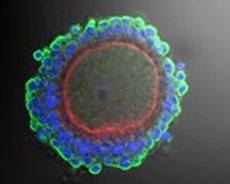third party reproduction background and overview
Third party reproduction includes any infertility treatment where a couple (or individual) is helped to achieve pregnancy by using another individual’s sperm, eggs, embryos or uterus.
third party reproduction background and overview
Third party reproduction includes any infertility treatment where a couple (or individual) is helped to achieve pregnancy by using another individual’s sperm, eggs, embryos or uterus.
These interventions range from the simple (the use of donor sperm by a single woman for an intrauterine insemination) to the complex (the use of both donor eggs and a gestational carrier by a couple for a cycle of IVF). Many legal, ethical and psychological issues frequently surround the more involved therapies. The following provides more details about these reproductive solutions.
egg (oocyte) donation
Egg donation is indicated when the cause of infertility is due to a decrease in the quantity and/or quality of a woman’s oocytes. All women are born with a finite number of eggs in their ovaries (estimated to be about 1-2 million). As a woman ages, both the quantity and quality of eggs naturally diminishes. Typically, by the time a woman approaches her mid-40’s a critical threshold is reached: although still ovulating and experiencing normal menstrual periods, the quantity and quality of remaining eggs is so low that even medically-assisted conception (IVF with her own eggs) is extremely unlikely to be successful.
Oocyte or egg donation has revolutionized the reproductive lifespan of women. Because the uterus remains fully functional throughout a woman’s life, the use of donor eggs can overcome a woman’s age as the sole limitation to reproduction. Prior to the advent of IVF, infertility diagnoses such as premature ovarian failure (POF) or severely diminished ovarian reserve (DOR) were synonymous with sterility. Today, the use of donated eggs is commonplace and has permitted a majority of female patients to have a high likelihood of conceiving, regardless of age or ovarian status.
Treatment protocol hinges around “cycle synchronization” between the donor (known or anonymous) and the recipient (patient). While the donor undergoes ovarian stimulation in the same fashion as a standard IVF cycle, the recipient receives hormones to prepare her uterus to receive an embryo. After retrieving eggs from the donor, embryos are created using sperm from the husband (or, less frequently, a sperm donor). After growth in the laboratory, embryos are transferred back into the uterus of the recipient.
Treatment with donor eggs carries a high likelihood of success. Regardless of the age of recipient, a single cycle of IVF with donor eggs results in pregnancy 50% of the time.
For more information about egg donation, please contact us at 707.259.1955 or info@napavalleyfertility.com.
gestational carrier
A gestational carrier is a type of surrogacy where an individual becomes pregnant and delivers a child with for another couple. The need for a gestational surrogate arises when one or more factors prohibit the successful use of one’s own uterus for carrying a pregnancy. In a common scenario, embryos created in the laboratory from the couples’ sperm and eggs are transferred to the gestational carrier, making the baby a genetic offspring of the couple. Other circumstances include the use of donor eggs or sperm in the process.
While this method of reproduction can seem complicated, it has helped many couples overcome a major hurdle in the road to family building.
For more information about gestational surrogacy, please contact us at 707.259.1955 or info@napavalleyfertility.com.
donor sperm
Donor sperm is generally used in one of the following situations:
1)For couples with a severe male factor
2)For couples with an inheritable genetic disease linked to the male
3)For females without a male partner
Depending upon the specific indication, donor sperm may be used with either intrauterine insemination (IUI) or in vitro fertilization (IVF).
The process begins with the selection of a specific donor from a sperm bank. The sperm bank houses samples that have been pre-screened for infectious and genetic diseases. They also provide access to a considerable amount of personal information on the donor.
Donor selection is a very personal process and we feel strongly that you should have access to a wide range of choices. Napa Valley Fertility Center works with both regional and national sperm banks and, for your convenience, we provided links to some of these below.
For more information about the use of third party reproduction solutions, please contact us at 707.259.1955 or info@napavalleyfertility.com.
third party reproduction

Egg (stained in red) with surrounding supportive cells (stained blue and green).

Napa Valley Fertility Center provides highly-attentive reproductive medicine and expertise in all aspects of infertility care. These include: in vitro fertilization (IVF), intrauterine insemination (IUI), ovulation induction, frozen embryo transfer, third party reproduction, male infertility/andrology, pre-implantation genetic diagnosis, and reproductive surgery. We also emphasize access to experimental treatments such as in vitro maturation (IVM) and offer fertility preservation therapies for women with cancer or benign conditions that threaten their reproductive lifespan. Dr. Peter Uzelac, our physician and medical director, is certified by the American Board of Obstetrics and Gynecology in Reproductive Endocrinology and Infertility. He is also a member of the Society for Reproductive Endocrinology and Infertility (SREI). Dr. Uzelac launched one of the first successful IVM programs in the United States.
©2010-2012 Napa Valley Fertility Center. All rights reserved.